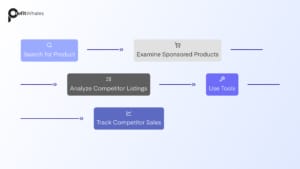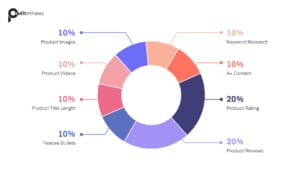In the ever-competitive world of Amazon, staying ahead of the competition is about more than just offering a great product. It’s about understanding the marketplace, identifying your key competitors, and crafting a strategy that allows you to outperform them. Amazon seller competitor analysis is the tool that enables you to do just that. By conducting a thorough Amazon competitor analysis, you can gain valuable insights into your competitors’ strategies, uncover opportunities for your business, and ultimately dominate your market. Whether you’re looking for an Amazon seller competitor analysis example or creating your own Amazon seller competitor analysis template, this guide will help you get started.
Why Amazon Seller Competitor Analysis Matters
Understanding why Amazon seller competitor analysis is essential and provides the foundation for any successful strategy on the platform. By diving deep into your competitors’ tactics, you gain insights that allow you to optimize your listings, pricing, and marketing efforts. This analysis is about more than just observing what others are doing; it’s about strategically positioning your brand to leverage market opportunities and outmaneuver competition. As Amazon’s competitors increase and the marketplace becomes increasingly crowded, the ability to conduct a detailed and practical competitor analysis is a critical skill for any seller aiming for long-term success. Understanding what is Amazon’s competitive advantage over others and how to exploit it can give you the upper hand.
The Strategic Importance of Understanding Your Competition
Understanding your competition is critical to succeeding on Amazon. Amazon’s marketplace is vast, with millions of products competing for customers’ attention. You can easily stay caught up with a comprehensive understanding of your competitors. A competitive analysis of Amazon allows you to see where your competitors are excelling and where they might fall short. This information is invaluable for adjusting your strategies to stay ahead.
By conducting an Amazon seller competitor analysis, you can identify key aspects of your competitors’ strategies, such as:
- Pricing: How they price their products relative to the market.
- Keywords: The specific keywords they target to gain visibility.
- Customer Engagement: Their approach to reviews, Q&A, and customer interaction.
- Advertising: The types of Amazon PPC campaigns they run and their effectiveness.
This knowledge enables you to position your product more effectively, ensuring that it stands out in a crowded marketplace. Additionally, understanding your competition helps you anticipate market trends and shifts, allowing you to stay agile and responsive to changes in the marketplace. Tools like an Amazon competitor analysis template can streamline this process.
Key Benefits of Competitor Analysis for Amazon Sellers
There are several benefits to conducting a thorough Amazon competitor analysis. Key among them are:
- Identifying Market Gaps: Discover underserved customer segments or product features by conducting a comprehensive Amazon market share analysis.
- Optimizing Listings: Learn from top-performing competitors to enhance your own product listings.
- Pricing Strategy: Set competitive yet profitable prices by understanding market trends.
- Enhancing Marketing Efforts: Adjust your advertising strategies based on competitor performance.
- Sales Tracking: Monitor competitors’ sales to forecast demand and adjust inventory levels.
These benefits are essential for any Amazon seller looking to maintain a competitive edge and achieve sustainable growth in a highly competitive marketplace.
Identifying Your Key Competitors on Amazon
Identifying your key competitors is the first step in developing a robust Amazon strategy. It’s not enough to simply know who the top sellers are; you need to understand who your direct and indirect competitors are and how they impact your market share. This process involves a combination of research, tools, and strategic thinking to ensure you have a clear picture of the competitive landscape. You can focus your efforts on your niche’s most significant threats and opportunities by identifying the right competitors.
How to Discover Your Competitors
To discover your Amazon key competitors, follow these steps:
- Search for Your Product: Begin by searching for your product or similar products on Amazon. The top results are often your direct competitors.
- Examine Sponsored Products: Pay attention to the sponsored products that appear in your search results. These sellers are actively competing for visibility.
- Explore the “Customers Also Bought” Section: This section on product pages can reveal indirect competitors who offer complementary or alternative products.
- Use Competitor Analysis Tools: Utilize tools like Jungle Scout or Helium 10 to discover sellers who may not rank as high but are still significant competitors.
By combining these methods, you can create a comprehensive list of your main competitors, which will be the foundation of your Amazon seller competitor analysis template.
Tools and Techniques for Effective Competitor Identification
Several tools and techniques can aid in identifying your Amazon key competitors:
- Jungle Scout: Offers insights into top sellers, sales estimates, and competitor rankings.
- Helium 10: Provides data on keyword rankings, sales volumes, and competitor product listings.
- AMZScout: Tracks competitors’ sales trends and offers in-depth market analysis.
- Amazon’s “Related Products” Feature: Helps identify indirect competitors that might not be immediately obvious.
- Social Media Monitoring: Tracks mentions of competing products and brands on platforms like Facebook, Instagram, and Reddit.
These tools and techniques provide a deeper understanding of the competitive landscape, helping you refine your strategy and stay ahead of the competition. Using a new competitor analysis tool can also uncover emerging threats before they become significant.
Analyzing Competitor Product Listings
Product listings are where the competition truly heats up on Amazon. Analyzing your competitors’ listings lets you see what they’re doing well and where they might need to catch up. This includes everything from their product titles and bullet points to the quality of their images and descriptions. By thoroughly evaluating these elements, you can learn what resonates with customers and how to improve your own listings. A well-optimized listing can make the difference between a potential customer choosing your product over a competitor’s.
Evaluating Titles, Bullet Points, and Descriptions
A successful Amazon listing relies heavily on well-crafted titles, bullet points, and descriptions. When analyzing your competitors’ listings, consider the following:
- Titles: Are they concise yet descriptive? Do they include relevant keywords?
- Bullet Points: Are key features highlighted clearly? Do they focus on benefits rather than just features?
- Descriptions: How detailed are the product descriptions? Do they address potential customer concerns or questions?
By understanding how your competitors use these elements, you can refine your own listings to be more compelling and informative, increasing the likelihood of conversions. An Amazon seller competitor analysis example can provide further insights into best practices.
H3: Visual Content: The Role of Product Images
Visual content is a critical component of any Amazon listing, and your Amazon competitor analysis should include a close examination of product images. High-quality images that showcase the product from multiple angles and in different contexts can significantly impact a customer’s purchasing decision.
When analyzing your competitors’ images, consider the following:
- Image Quality: Are they using professional photography?
- Product Features: Are all key features clearly shown in the images?
- Contextual Images: Are lifestyle images included to show the product in use?
- Enhanced Content: Are they utilizing Amazon’s A+ Content or Brand Stores to provide richer visual experiences?
If your competitors are excelling in these areas, it’s crucial to match or exceed their efforts to stay competitive. High-quality visuals can be the deciding factor for many customers.
Pricing Strategies: How to Compare and Compete
Pricing is one of the most critical aspects of Amazon’s competitive analysis. Customers often make purchasing decisions based on price, so it’s essential to understand how your competitors are pricing their products. This involves more than just comparing prices; you need to consider the value that your competitors offer for their prices.
To effectively compare and compete on pricing:
- Analyze Price Points: Look at the price ranges within your category. Are there significant differences? What are the standard prices for premium vs. budget options?
- Understand Pricing Tactics: Are competitors using dynamic pricing, discounts, or bundling to attract customers?
- Value Proposition: Compare your product’s features and benefits with those of your competitors to justify your pricing strategy.
This information will help you position your product effectively in the market, ensuring that your pricing strategy aligns with your overall business goals. An Amazon market share analysis can provide additional context for setting competitive prices.
Uncovering Competitor Keyword Strategies
Keywords are the lifeblood of visibility on Amazon. Understanding which keywords your competitors are targeting can give you a significant advantage. By uncovering and analyzing these keywords, you can refine your keyword strategy, ensuring your products are visible to the right audience. This step is crucial for improving your product’s ranking in search results and driving more organic traffic to your listings. With the right keyword strategy, you can enhance your visibility and outpace your competitors in the crowded Amazon marketplace.
Identifying and Using Competitor Keywords
One of the most effective ways to improve your product’s visibility on Amazon is by using the right keywords. During your competitor analysis, please take note of the keywords your competitors use in their titles, bullet points, and descriptions. You can use tools like Helium 10 or Jungle Scout to identify the top-performing keywords for your competitors’ products.
Once you’ve identified these keywords, incorporate them into your product listings. This can help improve your product’s search ranking, making it easier for potential customers to find your product over your competitors. However, ensure that the keywords you use are relevant and enhance the overall quality of your listing.
Tools for Keyword Analysis
There are several tools available that can assist you in analyzing competitor keywords. These tools offer valuable data that can help you optimize your listings and improve your search visibility:
- Helium 10: Tracks keyword rankings, search volumes, and competition levels.
- Jungle Scout: Provides insights into top keywords used by competitors and their effectiveness.
- MerchantWords: Analyzes Amazon search terms and suggests relevant keywords.
- Sonar by Sellics: A free keyword research tool that provides data on Amazon search terms.
In addition to these tools, consider using Amazon’s own search bar as a keyword research tool. Start typing a keyword related to your product and see Amazon’s suggestions. These suggestions are based on popular search queries, which can give you insights into what customers are searching for.
Monitoring Competitor Sales and Market Trends
Staying ahead of the competition requires ongoing monitoring of their sales and market trends. By tracking your competitors’ sales data, you can identify patterns and trends that might impact your business. This information is invaluable for making informed decisions about inventory, pricing, and marketing strategies. Additionally, understanding seasonal and market trends allows you to anticipate changes in customer behavior and adjust your strategies accordingly. Regular monitoring ensures that you are always aware of what’s happening in the market and can react swiftly to any shifts.
How to Track Competitor Sales Data
Tracking competitor sales data is an essential part of Amazon competitive analysis. Tools like Helium 10, Jungle Scout, and AMZScout can help you monitor your competitors’ sales performance over time. These tools provide estimates of monthly sales, which can help you gauge the demand for certain products and adjust your inventory levels accordingly.
In addition to these tools, pay attention to your competitors’ products’ best seller rank (BSR). A lower BSR indicates higher sales volume, which can provide insights into which products are performing well in the marketplace.
By tracking this data consistently, you can identify which products are gaining or losing popularity, helping you make strategic decisions about your product offerings.
Understanding Seasonal and Market Trends
Market trends and seasonality play a significant role in Amazon sales. Understanding these trends can help you anticipate changes in customer demand and adjust your strategies accordingly. For example, certain products may see a spike in sales during the holiday season, while others may be more popular during the summer months.
To understand these trends:
- Analyze Historical Data: Review past sales data to identify patterns.
- Monitor Competitor Activity: Track competitors’ promotions, discounts, and product launches to spot trends.
- Use Market Analysis Tools: Tools like Google Trends and Amazon’s own analytics can help you forecast demand and plan accordingly.
By monitoring your competitors’ sales trends, you can identify patterns and plan your inventory and marketing strategies around these trends. This ensures that you are always prepared for market shifts and can capitalize on opportunities as they arise.
Leveraging Competitor Insights for Your Amazon Strategy
Once you have gathered all the data from your competitor analysis, the next step is to leverage these insights to improve your Amazon strategy. This involves applying your knowledge to enhance your product listings, adjust your pricing, and refine your marketing efforts. The goal is to use the knowledge gained from your competitors to make your own products more competitive. By continuously adapting your strategy based on competitor insights, you can maintain a competitive edge and drive sustained growth on the platform.
Applying Competitor Analysis to Improve Your Listings
One of the most direct applications of competitor analysis is improving your product listings. Use the insights you’ve gained from analyzing your competitors’ titles, bullet points, descriptions, and images to optimize your own listings. Focus on highlighting your product’s unique features and benefits that differentiate it from the competition.
Additionally, ensure that your listings are optimized for the most relevant keywords. Incorporating the top-performing keywords from your competitor analysis can improve your product’s search ranking and attract more customers.
Adjusting Your Marketing and Pricing Based on Competitor Data
Competitor analysis also provides valuable insights into your marketing and pricing strategies. If your competitors are running successful Amazon PPC campaigns, consider how you can improve your own campaigns to compete more effectively. This might involve targeting similar keywords, adjusting your ad copy, or increasing your budget for high-performing ads.
When it comes to pricing, use the data from your competitor analysis to set competitive yet profitable prices. Consider offering promotions or discounts during peak seasons or when launching a new product to attract more customers and gain a competitive edge.
Next Steps to Stay Competitive on Amazon
After completing your Amazon seller competitor analysis, it’s essential to take action and implement the findings. Staying competitive on Amazon requires ongoing effort and adaptation. This section will guide you through the next steps to ensure you remain ahead of your competitors. Whether revisiting your listings, adjusting your pricing, or enhancing your marketing campaigns, continuous improvement is key to maintaining your position in the marketplace. The Amazon environment is dynamic, and staying competitive means being proactive and ready to evolve with the market.
FAQ
How can I identify top-performing competitors on Amazon?
To identify top-performing competitors, start by searching for your product or related products on Amazon and analyze the top results. Use tools like Helium 10 or Jungle Scout to gather data on sales volumes, reviews, and keyword rankings to pinpoint the leading competitors in your niche.
What are the key factors that differentiate successful sellers on Amazon?
Successful sellers often differentiate themselves through superior product quality, optimized listings, competitive pricing, and strong customer engagement. Additionally, they leverage Amazon’s advertising tools effectively and continuously refine their strategies based on market trends and competitor behavior.
How can I effectively analyze competitor pricing strategies on Amazon?
To analyze competitor pricing strategies, monitor their pricing over time using tools like AMZScout or Helium 10. Consider how their prices fluctuate during sales events, and compare their pricing with the features and benefits they offer. This will help you position your pricing competitively.
What are the best practices for outmaneuvering competitors in competitive niches?
Best practices include optimizing your product listings with high-quality images and compelling descriptions, using targeted keywords, and running effective Amazon PPC campaigns. Additionally, offering excellent customer service and encouraging positive reviews can help you stand out in a competitive niche.
How does Amazon’s algorithm impact competitor visibility?
Amazon’s algorithm impacts visibility by prioritizing products that are well-optimized for relevant keywords, have high sales volumes, and receive positive customer reviews. Understanding how the algorithm works can help you optimize your listings to improve your product’s visibility compared to your competitors.








